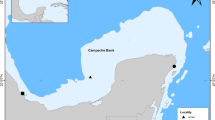Abstract—
In November 2020, the invasive ctenophore Beroe ovata Bruguière, 1789 was recorded in samples of gelatinous zooplankton from the northern and central parts of the Caspian Sea. The obtained values of the biomass of B. ovata and its main food object, the ctenophore Mnemiopsis leidyi (Agassiz, 1865), show an uneven distribution of these species across the studied area during the study period. A large range of individual sizes of the captured specimens of B. ovata suggests the possibility of its reproduction in the Caspian Sea during this period. The northern boundary of the range of the new invader within the study area was located near the Agrakhan Peninsula. The corresponding hydrological characteristics make it possible to suggest the limiting role of water salinity. Underwater studies using video equipment showed that B. ovata is confined to relatively warmer water layers. The peculiarities of the introduction of alien ctenophores into the Caspian Sea have much in common with similar processes in the Azov–Black Sea basin.




Similar content being viewed by others
REFERENCES
E. G. Arashkevich, N. E. Louppova, A. B. Nikishina, L. A. Pautova, V. K. Chasovnikov, A. V. Drits, O. I. Podymov, N. D. Romanova, R. R. Stanichnaya, A. G. Zatsepin, S. B. Kuklev, and M. V. Flint, “Marine environmental monitoring in the shelf zone of the Black Sea: assessment of the current state of the pelagic ecosystem,” Oceanology (Engl. Transl.) 55, 871–876 (2015).
M. E. Vinogradov, M. V. Flint, and E. A. Shushkina, “Research of the vertical distribution of mesoplankton using inhabited Argus submarine,” in Current State of the Black Sea Ecosystem (Nauka, Moscow, 1987), pp. 172–186.
M. E. Vinogradov, E. A. Shushkina, Yu. V. Bulgakova, and I. I. Serobaba, “Eating of zooplankton by Mnemiopsis and pelagic fishes in the Black Sea,” Okeanologiya (Moscow) 35, 569–574 (1995).
M. E. Vinogradov, L. P. Lebedeva, G. M. Vinogradov, et al., “Monitoring of the pelagic communities of the northeastern part of the Black Sea in 2004: macro- and mesoplankton,” Oceanology (Engl. Transl.) 45, 356–367 (2005).
The Sea Walnut Mnemiopsis leidyi in the Azov and Black Seas: Biology and Consequences of Invasion, Ed. by S. P. Volovik (Rostov-on-Don, 2000) [in Russian].
A. M. Kamakin, Yu. B. Studenikina, L. V. Stepanova, and E. G. Rubtsova, “Seasonal distribution of Mnemiopsis leidyi in the Caspian Sea in 2001,” Nauchn. Byull. Kasp. Plavuchego Univ., No. 3, 42–46 (2002).
A. M. Kamakin, V. B. Ushivtsev, et al., “Vertical distribution of the population of the sea walnut Mnemiopsis leidyi in the Caspian Sea,” in Fisheries Research in the Caspian Region: The Results of Scientific Researches of 2003, Tr. Kasp. Nauchno-Issled. Inst. Rybn. Khoz. (Caspian Scientific Research Institute of Fisheries, Astrakhan, 2004), pp. 191–198.
M. I. Karpyuk, D. N. Katunin, et al., Assessment of impact of Mnemiopsis leidyi on the Caspian Sea ecosystem and development of biotechnological principles of artificial invasion of Beroe ovata for biological monitoring of Mnemiopsis population,” in Fisheries Research in the Caspian Region: The Results of Scientific Researches of 2003, Tr. Kasp. Nauchno-Issled. Inst. Rybn. Khoz. (Caspian Scientific Research Institute of Fisheries, Astrakhan, 2004), pp. 165–183.
L. P. Lebedeva, E. A. Shushkina, M. E. Vinogradov, T. A. Lukasheva, and L. L. Anokhina, “Long-term transformation of the mesoplankton structure from the coastal waters of the Northeastern Black Sea under the impact of the ctenophores-invaders,” Oceanology (Engl. Transl.) 43, 670–675 (2003).
Z. A. Mirzoyan, M. L. Martynyuk, and E. V. Vyazun, “Specific development of Beroe ovata and Mnemiopsis leidyi in the Sea of Azov in present,” in Fishery and Protection of Fishery Reservoirs of the Azov-Black Sea Basin (2004–2005) (Rostov-on-Don, 2006), pp. 136–148.
E. A. Shushkina and M. E. Vinogradov, “The impact of Mnemiopsis on dynamics of the plankton community of the open areas of the Black Sea (1978–1989),” in Variability of the Black Sea Ecosystem: Natural and Anthropogenic Factors (Nauka, Moscow, 1991), pp. 248–260.
V. P. Ivanov, A. M. Kamakin, V. B. Ushivtzev, T. Shiganova, O. Zhukova, N. Aladin, S. I. Wilson, G. R. Harbison, and H. J. Dumont, “Invasion of the Caspian Sea by the comb jellyfish Mnemiopsis leidyi (Ctenophora),” Biol. Invasions 2, 255–258 (2000).
J. E. Purcell, “Quantification of Mnemiopsis leidyi (Ctenophora, Lobata) from formalin- preserved plankton samples,” Mar. Ecol.: Prog. Ser. 45, 197–200 (1988).
T. Weisse, M.-T. Gomoiu, U. Scheffel, and F. Brodrecht, “Biomass and size composition of the comb jelly Mnemiopsis sp. in the northwestern Black Sea during spring 1997 and summer 1995,” Estuarine, Coastal Shelf Sci. 54, 423–437 (2002).
Funding
The study was performed within the state assignments of the Southern Research Center, Russian Academy of Sciences (project no. АААА-А18-118122790121-5) and Shirshov Institute of Oceanology, Russian Academy of Sciences (project no. 0128-2021-0004).
Author information
Authors and Affiliations
Corresponding author
Additional information
Translated by N. Ruban
Rights and permissions
About this article
Cite this article
Sayapin, V.V., Ushivtsev, V.B., Oleynikov, E.P. et al. The Ctenophore, Beroe ovata Bruguière, 1789 – the New Invader in the Ecosystem of the Caspian Sea. Oceanology 61, 662–667 (2021). https://doi.org/10.1134/S000143702105012X
Received:
Revised:
Accepted:
Published:
Issue Date:
DOI: https://doi.org/10.1134/S000143702105012X




